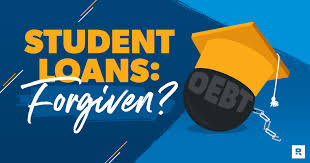Wells Fargo was once a significant player in the student loan market, offering private student…
Student loan forgiveness is a program that allows borrowers to have some or all of their federal student loan debt canceled, typically after meeting certain eligibility criteria.
These programs are designed to alleviate the financial burden of student loan debt for individuals who work in specific professions, serve in particular capacities, or meet other qualifying conditions.
Types of Student Loan Forgiveness Programs
There are several types of student loan forgiveness programs available, each with its own eligibility requirements and benefits. The most common programs include:
1. Public Service Loan Forgiveness (PSLF)
Overview:
PSLF is designed for borrowers who work in qualifying public service jobs, including government and non-profit organizations.
Eligibility Criteria:
- Must have Direct Loans or consolidate other federal student loans into a Direct Loan.
- Must work full-time for a qualifying employer.
- Must make 120 qualifying monthly payments under a qualifying repayment plan (such as Income-Driven Repayment plans).
Benefits:
- Remaining loan balance is forgiven after 120 qualifying payments, provided the borrower meets all eligibility requirements.
2. Teacher Loan Forgiveness
Overview:
This program provides forgiveness for teachers who work in low-income schools or educational service agencies.
Eligibility Criteria:
- Must teach full-time for five consecutive years in a low-income school or educational service agency.
- Must have Direct Loans or Federal Stafford Loans.
Benefits:
- Up to $17,500 in loan forgiveness for highly qualified teachers in certain subjects (such as math, science, and special education).
- Up to $5,000 in loan forgiveness for other eligible teachers.
3. Income-Driven Repayment (IDR) Plan Forgiveness
Overview:
Income-Driven Repayment plans adjust monthly payments based on income and family size. After 20 or 25 years of qualifying payments, the remaining loan balance is forgiven.
Eligibility Criteria:
- Must be enrolled in an Income-Driven Repayment plan (such as Income-Based Repayment, Pay As You Earn, or Revised Pay As You Earn).
Benefits:
- Remaining loan balance is forgiven after 20 or 25 years of qualifying payments, depending on the plan.
4. Perkins Loan Cancellation
Overview:
Perkins Loan Cancellation is available for borrowers who work in certain professions, such as teaching, nursing, and law enforcement.
Eligibility Criteria:
- Must have Federal Perkins Loans.
- Must work in a qualifying profession for a specified period.
Benefits:
- Up to 100% of the loan can be canceled over a period of five years, with a percentage of the loan forgiven each year of service.
How Student Loan Forgiveness Works
To benefit from student loan forgiveness programs, borrowers generally need to follow these steps:
- Determine Eligibility: Check if you qualify for any of the student loan forgiveness programs based on your employment, loan type, and repayment plan.
- Enroll in a Qualifying Repayment Plan: For many forgiveness programs, you must be enrolled in a specific repayment plan, such as an Income-Driven Repayment plan.
- Make Qualifying Payments: Make the required number of qualifying monthly payments. For PSLF, this is 120 payments; for IDR forgiveness, it is 20 or 25 years of payments.
- Submit Certification Forms: For programs like PSLF, submit the Employment Certification Form annually or whenever you change employers to verify that your employment qualifies.
- Apply for Forgiveness: After meeting all the requirements, submit the application for forgiveness to your loan servicer.
Considerations and Challenges
While student loan forgiveness can provide significant relief, there are important considerations and potential challenges:
- Strict Eligibility Requirements: Meeting the specific eligibility criteria can be challenging, and requirements may change.
- Documentation: Keeping thorough records of employment, payments, and certification forms is essential.
- Tax Implications: Forgiveness under IDR plans may be considered taxable income, though PSLF forgiveness is tax-free.
- Program Changes: Federal student loan programs are subject to changes in legislation and administration policies.
Conclusion
Student loan forgiveness programs offer a pathway to reducing or eliminating student loan debt for those who meet specific eligibility criteria. By understanding the different types of forgiveness programs, the eligibility requirements, and the process involved, borrowers can take advantage of these opportunities to alleviate their financial burden and achieve greater financial stability.
